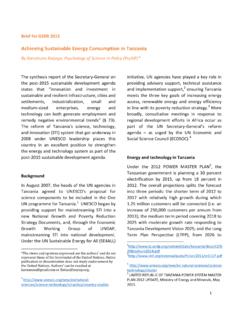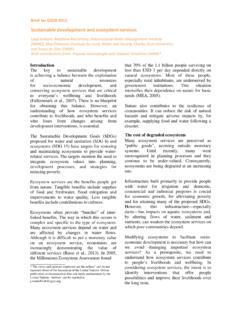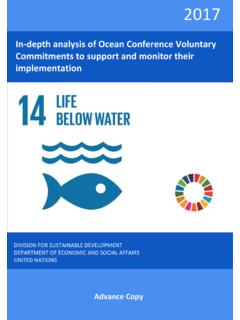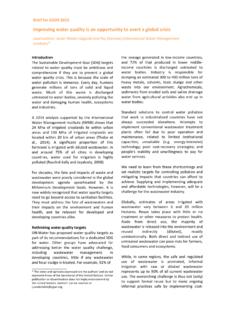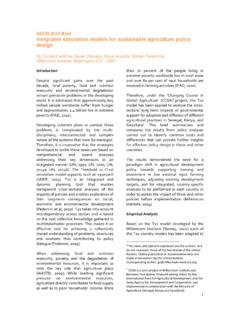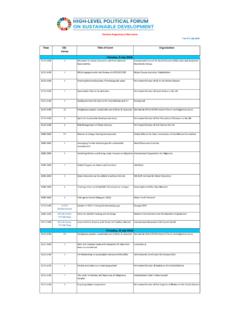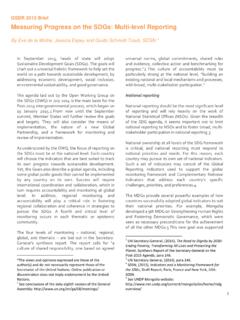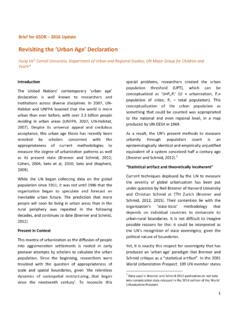Transcription of Federal Democratic Republic of Ethiopia
1 Federal Democratic Republic of Ethiopia The 2017 Voluntary National Reviews on SDGs of Ethiopia : Government Commitments, National Ownership and PerformanceTrends National Plan Commission June 2017 Addis AbabaTable of Contents Content Page 1. Introduction .. 1 2. Review Methodology and Processes .. 3 Review Methodology .. 3 The review processes .. 3 Contribution of Ethiopia to the preparation of the 2030 Sustainable Development Agenda .. 3 Owning the 2030 Sustainable development Agenda .. 4 Ensuring the implementation of the 2030 SDGs Agenda by all Stakeholders .. 4 3. Policies and Enabling Environment .. 6 4. Integrating the SDGs with the National Development Frameworks .. 6 5. Integrating the three Dimensions of the SDGs .. 10 6. Performance Instances of Goals and Targets.
2 10 SDG 4: Ensuring universal (inclusive) access to equitable and quality education .. 10 SDG-6: Ensuring availability and sustainable management of water and sanitation for all .. 11 SDG-7: Ensuring access to affordable & reliable energy for all .. 11 7. Implementation of SDGs .. 12 Performance of the SDGs in general .. 12 Leaving No One Behind .. 13 Financial Inclusiveness .. 14 Children s Right and Welfare .. 15 Road Safety and Traffic management .. 16 Participatory M&E System of the Analyses of the Main Theme: Eradication of Poverty and bringing about Prosperity: .. 17 Detail review of the Six SDGs .. 20 Goal 1: End poverty in all its forms everywhere .. 20 Goal 2: End hunger, achieve food security and improved nutrition and promote sustainable agriculture .. 24 Goal 3: Ensure healthy lives and promote well-being for all at all ages .. 26 Goal 5: Achieve gender equality and empower all women and girls.
3 28 Goal 9: Build resilient infrastructure, promote inclusive & sustainable industrialization & foster innovation .. 30 Goal 14. Conserve & sustainably use the oceans, seas & marine resources for sustainable dev t .. 34 8. Institutional mechnisms for implementing the SDGs .. 35 9. Means of Implementation of SDGs .. 36 10. Next Steps to Implement SDGs .. 37 11. Monitoring, Reporting and Review .. 38 Data, Statistics and Indicators .. 38 Monitoring and Review Methods Utilized .. 39 Challenges .. 39 12. Summary of the Report .. 40 General .. 40 Purpose, Methods and Processes of the VNRs .. 40 Review Findings .. 42 With respect to national commitments on SDGs: .. 42 With respect to national ownership on SDGs: .. 42 With respect to performance trends of SDGs: .. 42 Main Lessons and Challenges .. 45 13. Statistics Annexes .. 46 Annex 1. Performance Indicators on selected 47 Annex2. Performance of SDGs reviewed in detail.
4 48 1. Introduction Integrating with its national development frameworks, Ethiopia has implemented the Millennium Development Goals (MDGs) which spanned the period 2000 to 2015 and registered remarkable achievements. The MDGs were implemented through effective government leadership and coordination of all stakeholders in an organized and structured manner throughout the country. The integration of MDGs with the national development frameworks enabled full access to the national budget allocated and human capital deployed for the implementation, coordination, monitoring and evaluation of the national development frameworks by avoiding duplication of efforts. Ethiopia had also a recent experience in evaluating and capturing best practices and identifying challenges from the national review it had conducted on the performance of the MDGs where important lessons of experiences have been drawn at the national level with which Ethiopia has made significant contributions to the preparation of the 2030 Global Agenda for Sustainable Development.
5 Ethiopia has been pursuing pro-poor policies, implementing development plans and programs within which global development frameworks such as the MDGs, the Brussels Program of Action and its succcessor the Istanbul Program of Action for Least Developed Countries have been maintreamed with remarkable acheivements in economic growth, social development and environmental management . This, in turn has, helped in gaining replicable development experiences over the last decade and half. Informed by these experiences and having recognized future opportunities, Ethiopia has accepted with strong government commitments and endorsed the 2030 Agenda for Sustainable Development by the House of People Representatives with full sense of national ownership to implement the 2030 Agenda and its sustainable development goals (SDGs) as an integral part of its national development framework, the Second Five Year Growth and Transformation Plan (GTP II).
6 Accordingly, implementation of SDGs has been and is well in progress in Ethiopia . In response to the invitation made by the United Nations Economic and Social Council (UN-ECOSOC) to the Federal Democratic Republic of Ethiopia (FDRE) in August 2016 to engage in the 2017 Voluntary National Reviews (VNRs), the government of FDRE has been volunteered to prepare the 2017 VNRs on SDGs, and preceded with the review process by following the proposal for Common Reporting Guideline of the Secretary General of the United Nations. Accordingly, purposes of the review are established, review methodologies and processes, findings and lessons and challenges are clearly presented. The 2017 VNRs on SDGs of Ethiopia has two main purposes including (1) review of the process of national preparation for and implementation of the SDGs which has been undertaken in a manner reflecting the objective realities in the country and identify strengths, gaps, challenges and opportunities of implementation of the 2030 Agenda for Sustainable Development as part and parcel of GTP II (2) prepare and get approved the 2017 VNRs report by the Council of Ministers of the FDRE, present the report at the High Level Political Forum (HLPF) of the United Nations and receive constructive feedbacks from members countries and others participants of the 2017 HLPF which might be used as input in effective implementation of SDGs.
7 The National Planning Commission (NPC) of the Federal Democratic Republic of Ethiopia being responsible to coordinate and prepare the national development plan, monitor and review implementation progress/performance of the national plan and conduct studies to verify the implementation of the national plan, spearheaded the overall national coordination of the 2017 VNRs. Accordingly, NPC has established the necessary groundworks before the actual conduct of the 2017 VNRs and report preparation. These groundworks include preparation of a Concept Note and a Check-list to properly guide and coordinate the VNRs process at the national level, conducting consultation on the Concept Note and the Checklist with representatives of the private sector, civil society organizations, and professional associations. Consultations with government institutions that are more relevant for the 2017 VNRs review were technical and focused on (1) the rationale behind the 2017 VNRs (2) the data sources for the preparations of the 2017 VNRs (3) methodologies and major processes of the 2017 VNRs (4) the contents and presentation formats of the 2017 VNRs report (5) the timeline for the submission and presentation of the 2017 VNRs.
8 The 2017 VNRs at macro 2 and sectoral level was also coordinated by macro and sectoral Federal government institutions. The budget for the review processes have been approved by the Ministry of Finance and Economic Cooperation (MoFEC). The NPC established a team of experts at national level to coordinate, support, and facilitate the process of the VNRs. Similarly, government institutions were involved in the coordination and preparation of the 2017 VNRs. The teams of experts established at sectoral levels conducted the VNRs at sectoral level and submitted the compiled review report to the NPC. Subsequently, the NPC synthesized the draft 2017 VNRs report. Consultations have been conducted on the draft VNRs report at the Federal , regional and city administration levels with representatives of all stakeholders. Important feed-backs obtained from the consultations have been used to enrich the draft 2017 VNRs report.
9 The 2017 VNRs report having been reviewed by various stakeholders through national consultations held at the regional states, city administrations and Federal levels, and having incorporated the feedbacks, the final draft of the report has been approved by the government. The 2017 VNRs report has 13 sections including the introduction (Section1). Section 2 presents the review methodologies and processes; Section 3 deals with policies and the enabling environment; Section 4 focuses on the integration of the SDGs with the national development frameworks; Section 5 discusses the integration of the three dimensions of sustainable development; Section 6 outlines performance of selected SDGs; Section 7 deals with the implementation of SDGs; Section 8 presents institutional mechanisms for implementing SDGs; Secton 9 reports on means of implementation of SDGs; Section10 highlights next steps to implement SDGs; Section 11 presents monitoring, reporting and review of SDGs; Section 12 deals with the summary of the report including strengths and challenges, and the final section shows statistics-Annexes.
10 3 2. Review Methodology and Processes Review Methodology The principal method that has used for the preparation of the 2017 VNRs has been compiling and analyzing official sample-survey/census data, and administrative data Survey and census data and/or information were collected from the Central Statistics Agency (CSA), while administrative data and/or information have been collected from other pertinent government executive organs. Efforts were also made to collect information at the national, regional and city administration levels through engagement of different stakeholders. Collection & compilation of inputs for the 2017 VNRs on SDGs includes assessing the national legal frameworks, policy directions and other enabling environments, institutional co- ordination mechanisms for implementation, and performance monitoring and evaluation.

